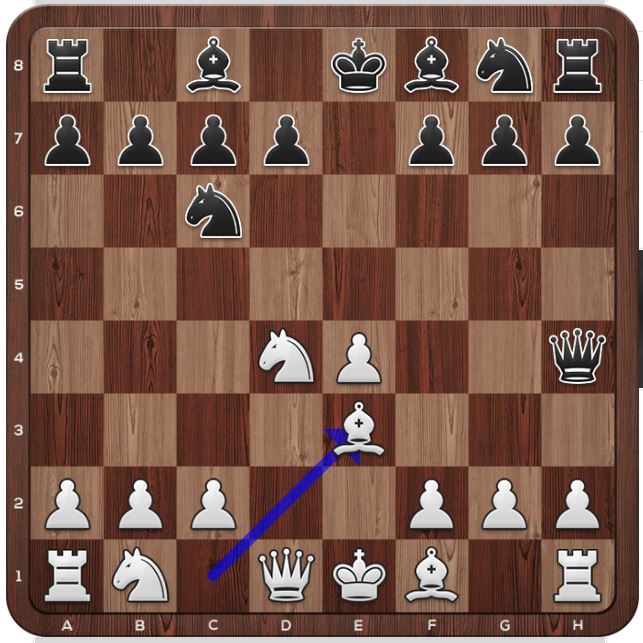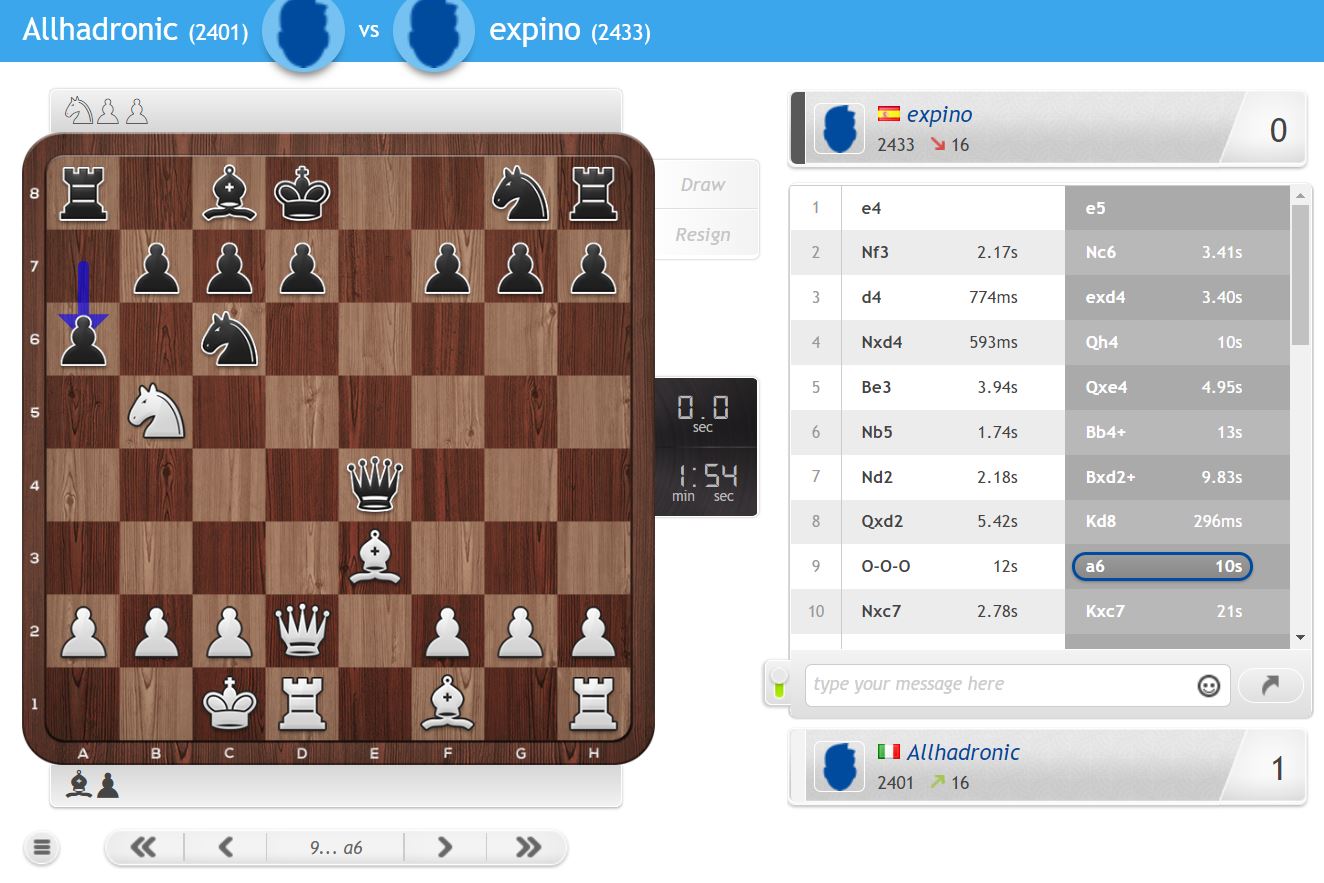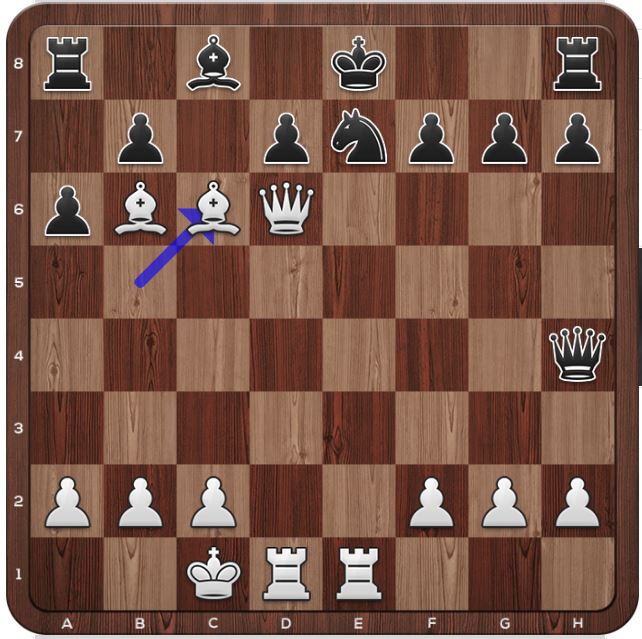For amateur chess players, playing a correct chess game is of course even harder. And if we talk of blitz chess - the kind of game where each player has only 5 minutes to do all the moves - this becomes almost impossible. So I am quite happy to report that, to the best of my understanding (I did not check with a computer yet), I did play a blitz chess game which is indeed flawless. And it is a miniature: this is what a very short, decisive game is called.
It is a remarkable fact in chess that the strongest moves are often unconventional, or surprising: they involve the sacrifice of material. The goal of chess is to capture the enemy king, and anything else is expendable if you can achieve that; but practice shows that one's pieces must be carefully looked after, as even a slight deficit can be paid dearly. So in a flawless game one can expect to see brilliant sacrificial moves, which are uncommon in regular practice.
When we talk about material sacrifices, they can be divided in two classes. There are the combinations, where the sacrifice is temporary or when it directly results in mate; these are the "less noble" ones, as the benefits of the sacrificed material can be calculated and assessed precisely. And then there are the positional sacrifices, where the payoff is not material, but rather the infliction of a distinct, persistent defect in the opponent's position. The sacrifice we see in this game is positional.
The game I present here was played yesterday evening on the chess24 site (www.chess24.com) against a player of roughly my strength - we are both rated around 2400 Elo points on the site (my official Elo is much lower, in the lower 2000's, and I believe the chess24 blitz Elo is inflationed by having beginners automatically start with 1500 points, while they should probably start at 1200). Here it is, without much further ado. I am white (my handle is AllHadronic).
AllHadronic - Expino, chess24 25/4/2018
1.e4 e5 2.Nf3 Nc6 3.d4 exd4 4.Nxd4 Qh4
This is an old variation in the Scotch game. Black tries to seize the initiative by a direct attack on the e4 pawn. Practice has shown that white can jettison the pawn in exchange for better development, and that is what I am used to play - although, after my next move, there is not much theory to know, so we are both on our own.
5.Be3!?
Sacrificing a pawn, as said (see diagram)

5. ... Qxe4
Black accepts the gift.
6.Nb5 Bb4+
With this check, black is trying to develop his pieces before defending the attacked c7 square. However, this strategy backfires, as he will soon be forced to part with the darksquared bishop, leaving his dark squares hopelessly weak for the remainder of the game.
7.Nd2!
Now black is forced to take, as 7. ... Ba5 (defending c7) runs in 8.Nxc7+! and the knight cannot be taken, or the black queen is lost.
7. ... Bxd2 8.Qxd2 Kd8
Black needs to defend against the threat of Nxc7, and the king move is the best one, as defending with the queen runs into bigger trouble: 8. ... Qe5 9.0-0-0!, and Bf4 followed by checks on the e- file give white the advantage.
9.0-0-0 a6?
One single mistake, and the game is lost. Black wants badly to play this move and repel the b5 knight, but the attempt fails spectacularly (diagram).

I attached the full screenshot of the board at this point, to show, not without pride, that I thought over my next move for 2.78 seconds. The knight _wants_ to be sacrificed on c7, as this will consacrate the dark squares to white's dominion until the end of the game.
10.Nxc7!!
a positional sacrifice, aimed at the dominion of the dark squares.
Kxc7 11. Qd6+ Kd8 12.Bb6+ Ke8 (diagram)

White is down by a piece, so if his attack does not concretize in a material gain or mate, he risks losing the game. Although white's compensation for the material deficit should be clear to any observer of the above diagram, here it might look as if black has a chance to consolidate by developing his g8 knight to e7, moving his king to f8, and then slowly regain control. What would you play in the position? To be fair, there are several winning moves - a simple one, for instance, is 13.Bd3 Qh4 14.Rhe1+ Nge7, when white does not even need to avoid the queen exchange, as e.g. 15.Re4 Qh6+ 16.Qxh6 gxh6 17. Rde1 still wins. But I argue that the move I found at the board is the most aesthetic one and it is quite strong:
13.Bb5!
The idea is to attack the Nc6 in the event of Re1+ Nge7. Taking the bishop with the useless a6 pawn would result in black losing the queen for rook and bishop, without dampening white's attack; one possible variation is 13. ... axb5 14. Rhe1 Qe6 15.Rxe6 dxe6 16.Qc7 (threatening Rd8 and mate) f6 17.Qxg7 and wins.
13. ... Nge7
Here black had an alternative in 13. ... Qg6 14.Rhe1+ Nge7 15.Bxc6 Qxd6 16.Rxd6 bxc6 (16. ... Kf8 17.Bc5 wins) 17.Bc5 Kd8 18.Rd3 Re8 19.Bb6 mate.
14.Rhe1 Qh4 15.Bxc6
The simple plan is carried through (diagram).

15. ... Qh6+
Black chooses to not regain the piece as if 15. ... bxc6 16.Bc5 it would be curtains; but the outcome is not different.
16.Qxh6 gxh6 17.Bc5 bxc6
17.... dxc6 would have lost the h8 rook after 18.Rxe7+ Kf8 19.Rd8+ Kg8 20.Bd4+
18.Bxe7! (diagram)

While the material is now perfectly even, and the presence of opposite-colour bishops could in 99% of other positions spell the complete equality of the game, in the present instance black is routed. The advantage of development of white is overwhelming - all his pieces cooperate in the attack, while it looks as if black has not moved a single piece yet! Now the threat is Bf6+, and this cannot be parried in any way.
18.... Rg8 19.Bg5+! Kf8 20.Bxh6+ Rg7 21.Rd3
and in this hopeless position black lost on time. White's plan is to pick up the g7 rook with Rg3-xg7.
----
Tommaso Dorigo is an experimental particle physicist who works for the INFN at the University of Padova, and collaborates with the CMS experiment at the CERN LHC. He coordinates the European network AMVA4NewPhysics as well as research in accelerator-based physics for INFN-Padova, and is an editor of the journal Reviews in Physics. In 2016 Dorigo published the book “Anomaly! Collider physics and the quest for new phenomena at Fermilab”. You can get a copy of the book on Amazon.




Comments